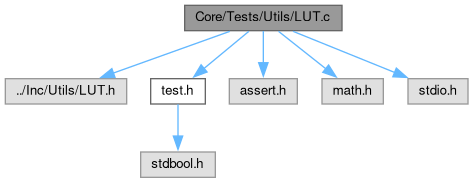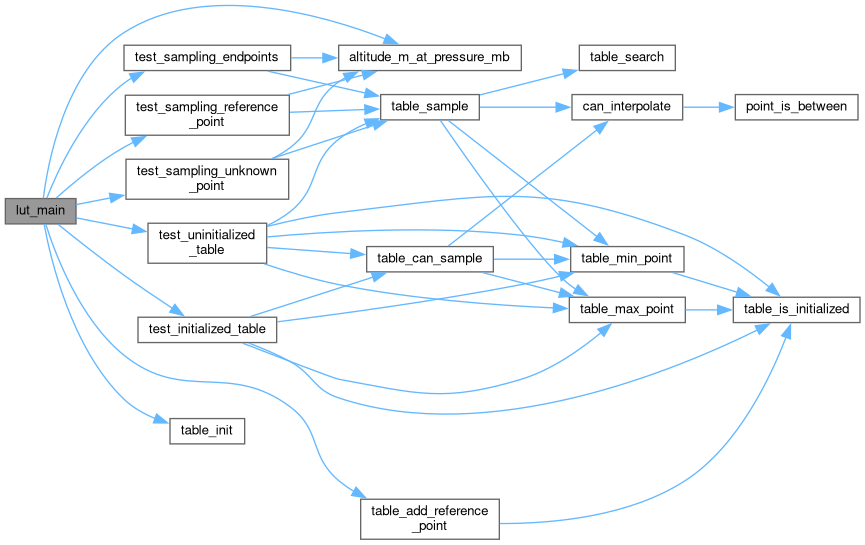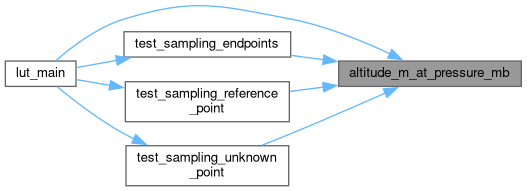#include "../Inc/Utils/LUT.h"#include "test.h"#include <assert.h>#include <math.h>#include <stdio.h>
Include dependency graph for LUT.c:

Go to the source code of this file.
Functions | |
| float | altitude_m_at_pressure_mb (float pressure_mb) |
| void | test_uninitialized_table (table *table) |
| void | test_initialized_table (table *table) |
| void | test_sampling_endpoints (table *table) |
| void | test_sampling_reference_point (table *table) |
| void | test_sampling_unknown_point (table *table) |
| void | lut_main () |
Function Documentation
◆ altitude_m_at_pressure_mb()
| float altitude_m_at_pressure_mb | ( | float | pressure_mb | ) |
◆ lut_main()
| void lut_main | ( | ) |
Definition at line 115 of file LUT.c.
115 {
116 table pressure_mb_to_altitude_m;
117 assert(table_init(&pressure_mb_to_altitude_m, 9));
118
119 test_uninitialized_table(&pressure_mb_to_altitude_m);
120
121 // Initializes the table with equally-spaced points using the transfer
122 // function
123 for (unsigned int reference_pressure_mb = 300; reference_pressure_mb <= 1100;
124 reference_pressure_mb += 100) {
125 assert(table_add_reference_point(
126 &pressure_mb_to_altitude_m, reference_pressure_mb,
127 altitude_m_at_pressure_mb(reference_pressure_mb)));
128 }
129
130 test_initialized_table(&pressure_mb_to_altitude_m);
131
132 test_sampling_endpoints(&pressure_mb_to_altitude_m);
133
134 test_sampling_reference_point(&pressure_mb_to_altitude_m);
135
136 test_sampling_unknown_point(&pressure_mb_to_altitude_m);
137}
bool table_add_reference_point(table *table, float in, float out)
Adds a reference point to the table.
Definition: LUT.c:79
Here is the call graph for this function:

◆ test_initialized_table()
| void test_initialized_table | ( | table * | table | ) |
Definition at line 41 of file LUT.c.
41 {
42 TEST(initialized_table, {
44 "table is uninitialized");
46 "min is undefined");
48 "min is first point in table", "min is not first point in table");
50 "max is undefined");
52 "max is last point in table", "max is not last point in table");
54 "cannot sample outside of domain (0 mb)",
55 "can sample outside of domain (0 mb)");
57 "cannot sample outside of domain (300 mb)");
58 })
59}
bool table_is_initialized(table *table)
Checks if the table has been fully initialized, with all reference points added.
Definition: LUT.c:53
const point * table_min_point(table *table)
Retrieves the point in the table with the least input value.
Definition: LUT.c:95
bool table_can_sample(table *table, float in)
Checks if the input input is valid for the table.
Definition: LUT.c:107
const point * table_max_point(table *table)
Retrieves the point in the table with the greatest input value.
Definition: LUT.c:101
Here is the call graph for this function:

Here is the caller graph for this function:

◆ test_sampling_endpoints()
| void test_sampling_endpoints | ( | table * | table | ) |
Definition at line 63 of file LUT.c.
63 {
64 float min_reference_pressure_mb = 300;
65 float max_reference_pressure_mb = 1100;
66 float min_reference_altitude_m =
67 altitude_m_at_pressure_mb(min_reference_pressure_mb);
68 float max_reference_altitude_m =
69 altitude_m_at_pressure_mb(max_reference_pressure_mb);
70 float altitude_m = 0.0;
71
72 TEST(sampling_min_reference_point, {
75 "reference altitude");
76 })
77
78 TEST(sampling_max_reference_point, {
81 "reference altitude");
82 });
83}
bool table_sample(table *table, float in, float *out)
Samples a output value from the table for an input value.
Definition: LUT.c:137
Here is the call graph for this function:

Here is the caller graph for this function:

◆ test_sampling_reference_point()
| void test_sampling_reference_point | ( | table * | table | ) |
◆ test_sampling_unknown_point()
| void test_sampling_unknown_point | ( | table * | table | ) |
Definition at line 101 of file LUT.c.
101 {
102 float pressure_mb = 650;
104 float altitude_m = 0.0;
105
106 TEST(sampling_unknown_point, {
108 float percent_error =
109 (altitude_m - expected_altitude_m) / expected_altitude_m * 100;
111 "expected altitude");
112 })
113}
Here is the call graph for this function:

Here is the caller graph for this function:

◆ test_uninitialized_table()
| void test_uninitialized_table | ( | table * | table | ) |
Definition at line 20 of file LUT.c.
20 {
21 TEST(uninitialized_table, {
23 "table is initialized");
25 "min is defined");
27 "max is defined");
29 "cannot sample outside of domain (0 mb)",
30 "can sample outside of domain (0 mb)");
32 "can sample outside of domain (300 mb)");
33 float altitude_m;
35 "sampling is okay");
36 })
37}
Here is the call graph for this function:

Here is the caller graph for this function:



